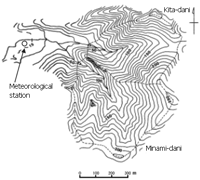
Tatsunokuchi-yama Experimental Watershed
Summary
- The Tatsunokuchi-yama Experimental Watershed is located on a small mountain ridge downstream of the Asahi-kawa river basin in Southern Okayama Prefecture, Japan. This area has a Seto Inland Sea climate, temperate with low-precipitation.
- Water shortages of farm ponds repeatedly occurred in this area in the 1920s, leading to the start of hydrological observations aiming to clarify forest influences on streamflow.
- Hydrological observation in the Tatsunokuchi-yama area has been conducted since 1937 in two adjacent catchments (Kita-dani and Minami-dani).
Data period
| Item |
Daily precipitation |
Daily runoff |
|
| Data source〵Location |
Meteor. sta. |
Minami-dani |
Kita-dani |
| 1 |
1937-1958 |
1937-1958 |
1937-1958 |
| 2 |
1959-1977 |
1959-1977 |
1959-1977 |
| 3 |
1978-1980 |
1978-1980 |
1978-1980 |
| 4 |
1981-2000 |
1981-2000 |
1981-2000 |
| 5, 6 (errata corrected) |
2001-2005 |
2001-2005 |
2001-2005 |
| 7 |
2006-2010 |
2006-2010 |
2006-2010 |
| 8 |
2011-2015 |
2011-2015 |
2011-2015 |
Data source
- Government Forest Experiment Station (1961) Statistical reports of hydrological observation in the Forested Experimental Watersheds (Daily precipitation and runoff), p. 173-225 (in Japanese).
- Forest Influence Unit and Okayama Experimental Site, Kansai Branch Station (1979) Statistical report of hydrological observation at Tatsunokuchiyama Experimental Watershed (January, 1959-December, 1977), Bulletin of Forestry and Forest Products Research Institute, 308, p. 133-195 (in Japanese with English caption).
- Forest Influence Unit and Okayama Experimental Site, Kansai Branch Station (1981) Hydrological observation report in Tatsunokuchi-yama Experimental Wastershed, Annual Report of Kansai Branch Station, 22, p. 56-69 (in Japanese).
- Goto, Y., Tamai, K., Kominami, Y., Miyama, T. (2005) Hydrological observation reports in Tatsunokuchi-yama Experimental Forest (January, 1981-December, 2000), Bulletin of Forestry and Forest Products Research Institute, 4(1), p. 87-133 (in Japanese with English abstract).
- Tamai, K., Goto, Y., Kominami, Y., Miyama, T., Hosoda, I. (2008) Hydrological observation reports in Tatsunokuchi-yama Experimental Watershed (January, 2001-December, 2005), Bulletin of Forestry and Forest Products Research Institute, 7(3),p. 125-138 (in Japanese with English abstract).
- Tamai, K., Goto, Y., Kominami, Y., Miyama, T., Hosoda, I. (2010) Erratum to: Hydrological observation reports in Tatsunokuchi-yama Experimental Watershed (January, 2001-December, 2005), Bulletin of Forestry and Forest Products Research Institute, 9(3),p. 149-151 (in Japanese with English abstract).
- Hosoda, I., Kominami, Y., Miyama, T., Okano, M., Goto, Y. (2019) Hydrological observation reports in the Tatsunokuchi-yama Experimental Watershed (January 2006-December 2010), Bulletin of Forestry and Forest Products Research Institute, 18(1),p. 111-128 (in Japanese with English abstract).
- Hosoda, I (2023) Hydrological observation reports in the Tatsunokuchi-yama Experimental Watershed (January 2011 - December 2015), Bulletin of Forestry and Forest Products Research Institute, 22(2),p. 89-107 (in Japanese with English abstract).
Details on Experimental Watershed
| Location | Gion, Okayama City, Okayama Prefecture, Japan | Topography |
| River system | Asahi-kawa river system |

|
| Latitude | 34° 42'N | |
| Longitude | 133° 58'E | |
| Altitude (m) | 15* |
| Kita-dani | Minami-dani | |
| Area (ha) | 17.3 | 22.6 |
| Altitude (m) | 36 - 246 | 50 - 257 |
| Geology | Paleozoic sedimentary rocks, plagioliparite, quartz-porphyry, biotite granite |
|
| Soil | Brown forest soil | |
| Vegetation | Naturally regrown forest primarily with Konara (Quercus serrata), Hisakaki (Eurya japonica), Soyogo (Ilex pedunculosa) and Ryobu (Clethra barbinervis), and artificial forests mainly comprised of Hinoki (Chamaecyparis obtusa) in 2010. | |
| Annual mean temperature (゚C) | 14.3** | |
| Annual precipitation (mm) | 1217*** | |
*** mean value over 1971-2000
Photos of Experimental Watershed
Contact:
Forest Hydrologic Cycle Team, Kansai Research Center, FFPRI


